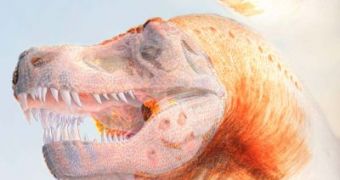In 1990, the Cheyenne River Indian Reservation, in South Dakota, provided the world with the most complete Tyrannosaurus Rex fossil to date, a beautiful specimen named Sue. The remains went on to be sold for the highest sum ever paid for a dinosaur, and became a permanent exhibit at the Field Museum of Natural History, in Chicago, Illinois. Studies have shown that it is between 67 and 65.5 million years old, and that the animal itself lived for about 28 years, which makes it the oldest T. Rex ever found. However, recent analyses have revealed that it may have been killed by parasites, rather than by violent clashes with predators, LiveScience reports.
Studies done on Sue's bones revealed that the dinosaur had suffered a large number of injuries over the course of its long life, including broken ribs, fractured bones, torn tendons, and a shattered shoulder blade. It also apparently suffered from arthritis, as evidenced by the patterns in which its vertebrae were fused together in the spinal cord. But, in spite of surviving all this damage to its body, experts believe that it was pathogen infections that finally got the best of it. The marks on its skull, which some believe to be bite marks, now prove to be the work of a microorganism.
Biologists say that the infection affected the dinosaur's throat and mouth, and that it may have been so severe, that it made the 42-foot-long, seven-ton creature starve to death. That is a bit ironic, they note, how all those injuries could not bring it down, but a tiny pathogen could. Moreover, studies have shown, the microorganism that Sue got was the same as the one still affecting birds today – trichomonosis. The condition is caused by the protozoan Trichomonas gallinae.
“It's ironic to think that an animal as mighty as 'Sue' probably died as a result of a parasitic infection. I'll never look at a feral pigeon the same way again,” University of Queensland researcher Steven Salisbury says. In pidgins, the protozoan causes little damage, but it severely affects birds of prey, such as hawks and falcons. The lesions they develop on their beaks are very similar to the ones found on Sue's skull, experts report. “We don’t think it is a coincidence that a significant number of adult tyrannosaur specimens show both face-biting marks and evidence of a trichomonosis-like disease. Previous studies have shown that up to 60 percent of tyrannosaur specimens display evidence of face-biting,” he adds.
“This leads us to suspect that tyrannosaurs might have been the source of the disease and its transmission in its environment. The lesions we observe on Sue suggest a very advanced stage of the disease and may even have been the cause of her demise,” University of Wisconsin in Madison (UWM) vertebrate paleontologist Ewan Wolff shares. “The discovery gives us an insight into the dinosaur immune system. The response of tyrannosaurs to this trichomonosis-like disease is almost identical to that found in living birds. These simple holes in tyrannosaur jaws give us a dramatic example of an avian-like defense system in action,” he concludes.

 14 DAY TRIAL //
14 DAY TRIAL //